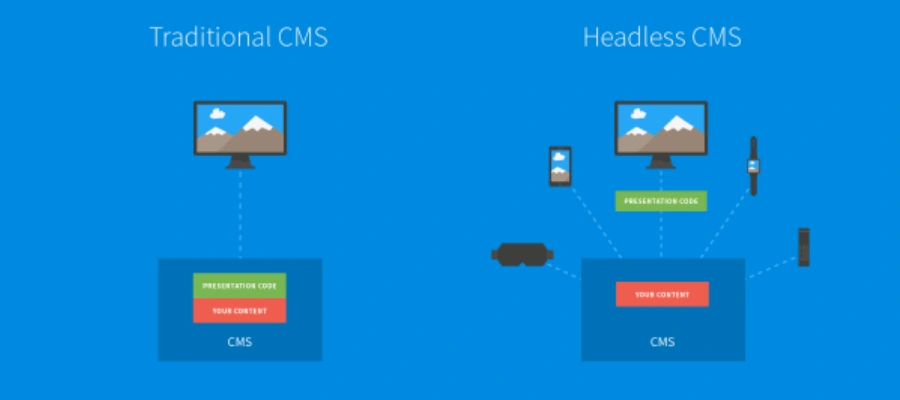What Is a Headless CMS and Whether we Should Use One?
Only back-end content management system built to use as the content repository is headless content management system or headless CMS. A headless content management system, or headless CMS. Headless CMS makes content accessible via a RESTful API for display on any device.

The term “headless” comes from the concept of removing the “head” ( frontend ) of the website and storing just the “body” (the back end, i.e. the content repository).
A standard CMS typically blend the content and presentation layers of a website, a headless CMS is just the content component. Its main focus is to give a good administrative interface to the content organizer. It simplifies the content workflows, collaboration and categorizes the content. It doesn’t concern itself with presentation layers, templates, site structure, or design, but rather stores its content in a pure format and provides access to other components (For example. content is available through APIs which can be used by any framework)
Advantages of Headless CMS software
● Universal channel ease:
The content created in a headless CMS is “clean” and can be reused across many channels, including website, mobile app, digital assistant, virtual reality, smart watches, etc. It is accessible at any place and at any time.
● Minimal operating costs:
Headless CMSs are usually economical to install and run than their monolith counterparts, especially as they are typically built on a cloud model where multi-tenant options keep the running costs low.
● Agile Methodology:
Headless CMS uses an Agile methodology. Both content producers and developers can work together. Project finishes faster as multiple people can work together.
● Straightforward:
Conventional CMS systems tend to be burdensome and complex* as vendors attempt to offer every available feature in one box. The main focus of the headless system is content management. Since everything is manageable from one back end, it becomes simple to use on daily basis.
● Limberness:
Content editors can work in whichever headless CMS they like and developers can build any kind of front end they want in their preferred language (e.g. Ruby, PHP, Java, or Swift) They just need to integrate the API with the framework they prefer This gives flexibility of writing code in multiple languages to capture additional functionality and efficiency not available in a single language.
● Cloud Plastic:
The clean content and stateless APIs of headless CMSs enable high scalability, especially as the architecture fully leverages the elasticity of a cloud platform.
● Safety of System:
Rather than directly getting content from the database, content is provided through a high-performance Content Delivery Network, so the risk of distributed denial-of-service attacks (DDOS) is reduced.
Disadvantages of Headless
● Challenging process:
Managing multiple systems can be challenging and a team’s knowledge base must cover them all.
● No framework support:
Since pure headless CMSs don’t deal with the presentation layer, developers may have to create some functionality, such as website navigation, themselves.
● Developer dependency:
Marketers may end up relying more on developers in certain scenarios, e.g. creating a landing page with a custom layout.
● Only Content:
As pure headless CMSs do not typically provide the concept of pages and web sitemaps, content editors need to adapt to the fact that content is organized in its pure form, independently on the website or another channel.
Here’s a summarized list of headless CMSs. *The list is in no particular order.
● Butter CMS
● Kentico Cloud
● Content stacks
● Contentful
● dotCMS
● Mura
● Cloud CMS
● Cockpit CMS
● Core dna
● Craft CMS
● Zesty.io
● Directus
● Storyblok
● GraphQL CMS
● Gentics Mesh
● Cosmic JS
● Prismic.io
● Quintype
● Sanity
● Scrivito
● Squidex
● DNN Evoq Content
● Strapi
● Superdesk
Headless WordPress or Drupal
For WordPress fans, there are many ways to make WordPress headless CMS. For example, you can use WordPress Rest API and in front end use React App. This setup gives greater limberness while using your favorite CMS you are familiar with.
For Drupal fans, it is even easier since Drupal 8 comes packaged with the RESTful Web Services module. Drupal is large community support and this framework would ideal for developers who want to headless architecture. However keep in mind Drupal is not designed for this approach.
Modifying traditional CMS with new tricks is going against the wind. Neither WordPress nor Drupal were built with the purpose of being headless, so you may be better off learning from an open source option like Cockpit or Directus depending on your needs.
Summary
Content management is a monotonous task, but someone has to do it. Luckily a nice CMS can remove the burden from the developers and allow them to utilize their energy elsewhere. Choice of using headless CMS depends on the project requirement but it is important at least to get familiarize yourself with the concept since they are becoming more and more popular in content management system ecosystem.